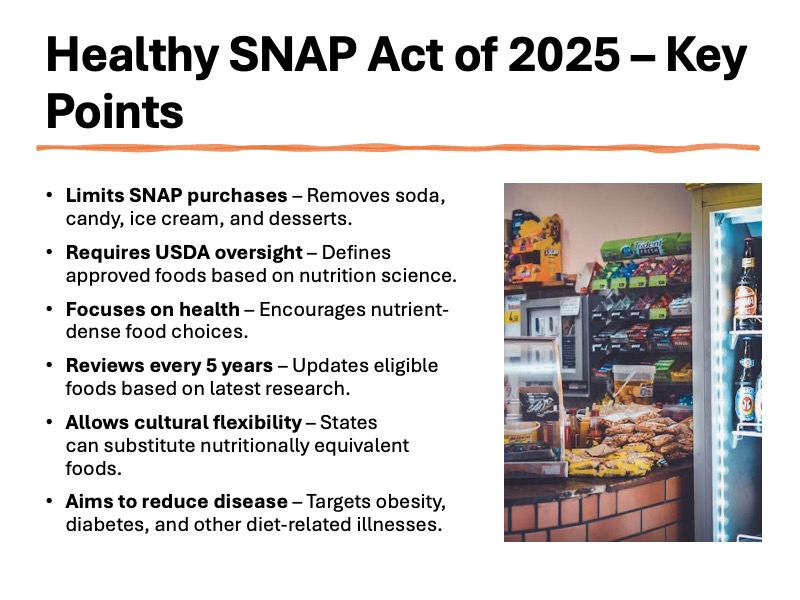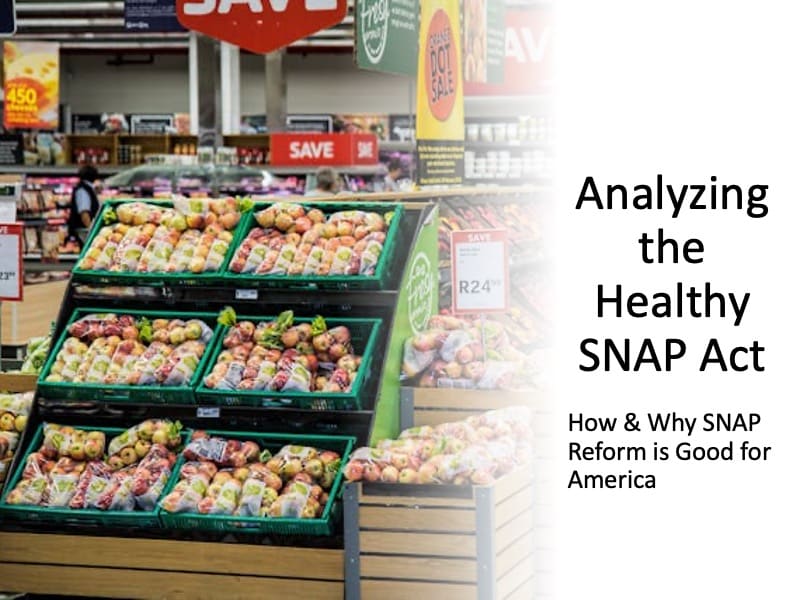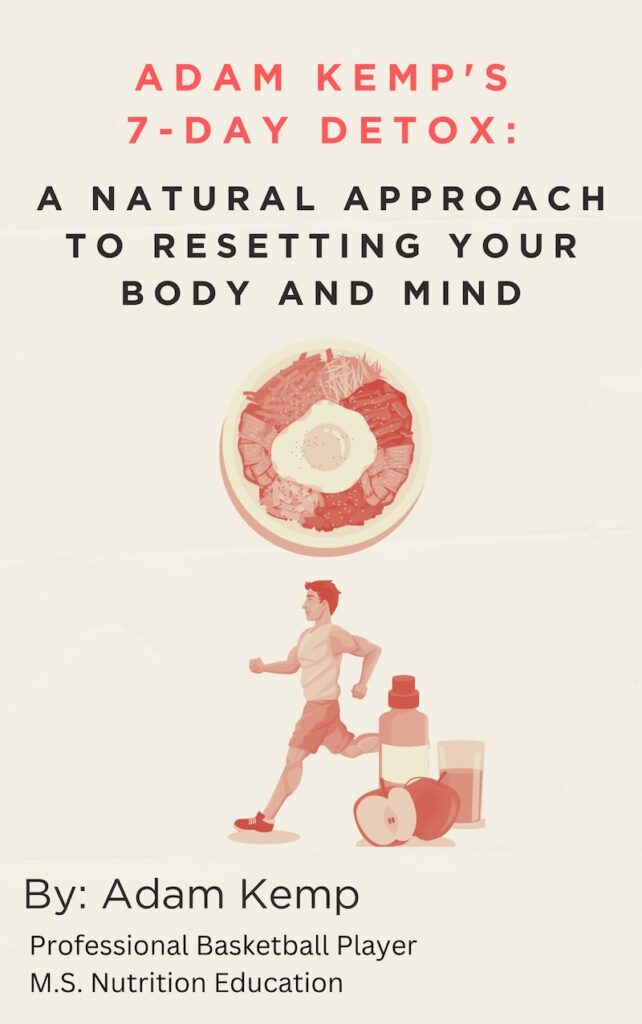Healthy SNAP Act – How & Why SNAP Reform is Good for America
The Healthy SNAP Act is a necessary step toward improving public health, reducing healthcare costs in the United States, and ensuring that government assistance programs truly support those in need.
While I generally advocate for minimal government interference, SNAP reform is necessary because of the undeniable link between the SNAP participants and development of chronic, preventable diseases.
Right now, the program indirectly fuels a pipeline from food insecurity to nutrition-related illnesses like obesity, diabetes, and cardiovascular disease.
This not only harms the health of SNAP participants but also places an overwhelming financial burden on taxpayers through Medicare and Medicaid.
Excluding unhealthy foods—starting with soda—ensures that SNAP remains a program designed to nourish, not harm.
Just as the government already restricts the purchase of alcohol and tobacco with SNAP benefits due to their public health impact, it makes sense to apply the same standard to ultra-processed foods that contribute to diet-related disease.
However, SNAP reform should not just be about restricting harmful purchases.
In this article, I’ll also outline actionable steps the government should take to support SNAP participants in making healthier choices—such as increasing incentives for fresh produce and funding nutrition education programs.
A well-designed SNAP reform will protect low-income families while also reducing healthcare costs and preventing food industry giants from profiting off taxpayer dollars at the expense of public health.
By modernizing SNAP, we can ensure that it serves its original purpose—providing real nutrition for those who need it most.
We can Make America Healthy Again by ensuring that SNAP truly supports nutrition and well-being, rather than fueling the cycle of diet-related diseases and healthcare burdens.
What the Healthy SNAP Act Proposes

The Healthy SNAP Act of 2025 aims to reform the Supplemental Nutrition Assistance Program (SNAP) by establishing a list of approved foods and food products based on scientific research and public health guidelines.
The bill directs the Secretary of Agriculture to designate eligible food items that contain essential nutrients lacking in American diets while promoting overall population health.
Under this legislation, soft drinks, candy, ice cream, prepared desserts (cakes, pies, cookies), and similar products would no longer be eligible for SNAP purchases.
The bill ensures that approved foods meet appropriate fat, sugar, and salt content standards, reflecting the latest nutrition science and public health concerns.
Additionally, the bill mandates a scientific review of approved foods every five years to align with evolving dietary guidelines and cultural eating patterns.
States may substitute culturally relevant foods, provided they are nutritionally equivalent to the designated items.
The goal of the Healthy SNAP Act is to prioritize nutrient-dense foods, reduce diet-related diseases, and improve the long-term health outcomes of SNAP participants.
Why Does the United States Need to Reform SNAP?
Just as I support a soda tax to reduce the consumption of sugar-sweetened beverages and the inevitables train on American taxpayers it creates through increased Medicaid and Medicare costs, reforming SNAP with the 2025 Healthy Snap Act is necessary to reduce the consumption of processed and ultra-processed foods that inevitably promote chronic, preventable diseases.
SNAP Purchases Are Largely Made on Processed & Ultra-Processed Junk Foods
Every year, billions of taxpayer dollars are funneled into the purchase of processed and ultra-processed foods through the Supplemental Nutrition Assistance Program (SNAP)—foods that contribute directly to the nation’s chronic disease epidemic.
Of the $113 billion annual SNAP budget:
- Over 40% of the entire SNAP budget ($45.2 billion) likely funds the purchase of processed and ultra-processed foods that contribute to chronic disease.
- A minimum of $22.6 billion annually is used specifically on ultra-processed junk foods like soda, candy, and salty snacks.
- This means taxpayers are funding nearly half of SNAP expenditures on foods that drive obesity, diabetes, and heart disease, while also footing the bill for the Medicare and Medicaid costs associated with these conditions.
This includes sugar-sweetened beverages, candy, ice cream, and processed snacks—products that fuel obesity, diabetes, and other metabolic disorders.
The single most frequently purchased SNAP item is sugar-sweetened beverages, accounting for 9.3% of all program expenditures.
In fact, the SNAP program itself is a major revenue driver for food corporations like Coca-Cola and PepsiCo, contributing an estimated 20-25% of their U.S. revenues.
Furthermore, soda companies are known to exploit the SNAP benefit cycle by strategically increasing marketing efforts when recipients receive their funds.
Research has found that during the first nine days of the month—when many SNAP benefits are issued—retailers were 4.35 times more likely to display sugar-sweetened beverages in areas with high SNAP enrollment.
By flooding stores with prominent soda advertisements and displays, these companies ensure that a significant portion of SNAP dollars is funneled into their products.
Without intervention, the situation will only worsen.
Over the next decade, taxpayers are projected to unintentionally subsidize $240 billion in purchases of unhealthy, ultra-processed foods through SNAP—$60 billion for soda alone.
This means that, beyond providing food security, SNAP is also acting as a massive taxpayer-funded subsidy that props up the ultra-processed food industry at the expense of public health.
Many SNAP Participants Prefer SNAP Reform with Incentives for Purchasing Healthy Foods
Reforming SNAP isn’t just about protecting taxpayer dollars—it’s about breaking the cycle of food insecurity, poor nutrition, and skyrocketing healthcare costs caused by chronic diet-related diseases.
Importantly, most SNAP participants recognize the program’s value in reducing food insecurity but also support reforms to improve its nutritional impact.
A majority—68% of participants—preferred a version of SNAP that incentivizes healthy foods while excluding sugary beverages, and that number rose even higher when paired with a 50% increase in benefits.
SNAP Forces Taxpayers to Pay Twice – Subsidized SNAP & Increased Medicare, Medicaid Spending
Current SNAP policy is a double financial burden on taxpayers—they pay once to subsidize the purchase of unhealthy, ultra-processed foods and pay again for the skyrocketing healthcare costs caused by diet-related diseases.
Every year, $23 billion in taxpayer money is spent on processed and ultra-processed foods through SNAP, fueling obesity, diabetes, and other chronic illnesses.
The long-term consequences are devastating.
A 2021 Rockefeller Foundation report found that diet-related diseases cost the U.S. $1.1 trillion annually, accounting for approximately 25% of the $4.9 trillion the United States spends on healthcare annually.
Medicaid alone—a program heavily used by low-income Americans and the largest federal payment to states, including many SNAP participants—cost taxpayers $616 billion in 2023, nearly 10% of the entire federal budget.
With ultra-processed foods dominating the diets of low-income Americans, and with many of these products being intentionally designed to be addictive, Congress must take action.
A phased approach to SNAP reform should begin with the immediate exclusion of soda and other sugar-sweetened beverages, breaking the cycle of taxpayer-funded chronic disease.
How to Reform SNAP to Reduce Healthcare Spending & Improve Health Outcomes for SNAP Participants
Reforming SNAP should have a measurable, attainable goal: reduce taxpayer spending while improving health outcomes for SNAP participants.
Using the SMART goal framework—Specific, Measurable, Achievable, Relevant, and Time-bound—this objective becomes both practical and trackable:
- Specific: Reduce taxpayer-funded purchases of ultra-processed foods through SNAP while increasing access to nutrient-dense whole foods.
- Measurable: Track SNAP expenditures on unhealthy items and correlate them with Medicaid and Medicare spending on diet-related diseases. Metrics like obesity rates, diabetes prevalence, and cardiovascular disease incidence among SNAP recipients can serve as benchmarks.
- Achievable: Incremental changes—such as eliminating soda and sugar-sweetened beverages from SNAP—have already been modeled to produce billions in healthcare savings while still ensuring food security.
- Relevant: With diet-related diseases costing the U.S. over $1.1 trillion annually, targeting the largest federally funded food assistance program is a direct and impactful way to address this crisis.
- Time-bound: Policy changes, such as excluding soda from SNAP, could be implemented within a one-year window, with five-year evaluations assessing the impact on public health and taxpayer savings.
By strategically modifying SNAP, the government can achieve a win-win scenario: lowering healthcare costs and breaking the cycle of chronic disease in vulnerable populations.
Additionally, SNAP reform should focus on empowering recipients to make healthier choices while reducing long-term taxpayer burdens from chronic disease.
Effective policy changes must incentivize nutritious purchases, increase access to fresh food in underserved areas, and stimulate local economies by supporting small farmers and food suppliers.
Incentivizing Healthy Choices
A key step in reforming SNAP is rewarding healthy purchases.
Incentivizing fruit and vegetable purchases through the Supplemental Nutrition Assistance Program (SNAP) is highly effective in improving health outcomes and reducing healthcare costs.
Research indicates that 30% financial incentive for fruits and vegetables alone could prevent 303,900 cardiovascular disease (CVD) events, gain 649,000 quality-adjusted life years (QALYs), and save $6.77 billion in healthcare costs over a lifetime (Mozaffarian et al., 2018).
When combined with a restriction on sugar-sweetened beverages (SSBs), the impact increases significantly, preventing 797,900 CVD events, gaining 2.11 million QALYs, and saving $39.16 billion in healthcare costs (Mozaffarian et al., 2018).
From a societal perspective, these interventions are cost-saving, and even from a government affordability standpoint, adding SSB restrictions makes the policy highly cost-effective within 10 years ($68,857/QALY) and very cost-effective over a lifetime ($5,216/QALY) (Mozaffarian et al., 2018).
These findings support implementing SNAP incentives as a strategic public health investment to reduce diet-related disease burdens while lowering long-term medical expenses.
One of the most effective models for this is the Double Up Food Bucks program, which matches every SNAP dollar spent on fruits and vegetables with an additional dollar for more fresh produce.
This program has already demonstrated higher fruit and vegetable consumption among low-income families, increasing overall diet quality without restricting consumer freedom.
By scaling up this initiative, SNAP can directly improve nutritional outcomes and reduce dependency on ultra-processed foods.
How to Implement:
- Expand Double Up Food Bucks nationwide to all SNAP-eligible retailers (grocery stores, farmer’s markets, local food co-ops).
- Increase funding for nutrition incentive programs that make healthy food more affordable.
- Implement targeted marketing campaigns to educate SNAP participants on the benefits of the program.
By making nutritious foods more accessible and affordable, this reform empowers individuals while driving down healthcare costs associated with poor diet.
Stimulating Local Economies Through Healthy SNAP Spending
Beyond improving individual health, shifting SNAP spending toward local produce and specialty crops can create economic opportunities.
When SNAP recipients spend their benefits on locally sourced fruits and vegetables, it boosts small farms and independent food suppliers, rather than fueling corporate profits of ultra-processed food manufacturers.
A stronger local food economy leads to:
- More jobs in agriculture and food production.
- Increased revenues for small farmers, reducing reliance on subsidies.
- Better food access in communities that lack grocery stores.
How to Implement:
- Provide SNAP-specific incentives for purchasing produce from local farmer’s markets.
- Fund initiatives that connect small farms with urban food programs to serve low-income communities.
- Offer small business grants to support healthy food entrepreneurs in underserved areas.
By redirecting taxpayer-funded SNAP benefits toward local food systems, this reform stimulates job creation and keeps money circulating in communities rather than sending it to multinational food corporations profiting off ultra-processed junk food.
Tackling Food Deserts & Food Swamps
One of the biggest barriers to healthy eating is lack of access.
According to the USDA, roughly 53.6 million Americans live in “food deserts” —low-income areas where fresh produce is scarce, but processed junk food is widely available.
Even worse, food swamps—areas where fast food and convenience stores dominate over grocery options—make it nearly impossible for residents to find affordable, nutritious foods.
SNAP reform must prioritize eliminating food deserts and food swamps by making fresh, healthy food more available.
How to Implement:
- Offer tax incentives for grocery stores and farmer’s markets to set up in underserved communities.
- Provide grants for mobile markets and produce delivery services in urban and rural areas.
- Partner with community organizations to develop food hubs that source local produce at reduced costs.
Why It Works:
- More access to fresh food = healthier SNAP purchases.
- Reduces dependence on fast food and processed meals.
- Lowers long-term healthcare costs by improving overall diet quality.
This approach ensures that SNAP recipients aren’t just given financial assistance, but also have the ability to make healthy choices where they live.
Building Infrastructure for Long-Term Change
To permanently address food insecurity, policymakers must invest in infrastructure that allows communities to grow and distribute their own healthy food.
Farmer’s Markets in Urban Areas
- Tax incentives for establishing farmer’s markets in low-income areas.
- Expanded Double Up Food Bucks opportunities at farmer’s markets.
- Financial support for mobile markets bringing fresh produce to food deserts.
Urban Agriculture Grants
- Federal grants for community gardens and urban farming projects.
- Funding for greenhouse and hydroponic farming to increase year-round food production.
- Education programs teaching gardening, nutrition, and sustainable food sourcing.
Urban farming has been proven to not only increase access to fresh food but also improve community mental well-being, reduce food insecurity, and promote economic resilience.
Final Thoughts: Why the Battle for SNAP Reform Needs to Be Won This Year with the Healthy SNAP Act
The Healthy SNAP Act is a key step in SNAP Reform, and the fight for SNAP reform is not just about nutrition policy—it’s about protecting public health and ending corporate profiteering at the expense of low-income Americans.
For decades, major food companies, many once owned by tobacco giants like Philip Morris and RJ Reynolds, have used the same addictive product formulation and marketing tactics to drive sales of ultra-processed foods, fueling the obesity epidemic, diabetes, cardiovascular disease, and premature mortality.
Despite growing evidence that soda and other hyper-processed foods contribute directly to poor health outcomes, industry lobbyists continue to frame SNAP restrictions as paternalistic while benefiting from a hidden subsidy that funnels taxpayer money into their pockets.
Meanwhile, the rise of GLP-1 medications like Ozempic expose the true cost of inaction—billions in Medicaid and Medicare spending to treat diet-related diseases that could have been prevented through smarter nutrition policies.
SNAP has long excluded alcohol and tobacco due to their harmful health effects, and it’s time to apply that same standard to ultra-processed junk foods, starting with soda.
Reforming SNAP now is not about limiting choice—it’s about ensuring that federal nutrition assistance dollars serve their intended purpose: improving health and reducing the burden of chronic disease on individuals and society.
This battle must be won this year, before more lives and taxpayer dollars are wasted on preventable illnesses.
This website does not provide medical advice. This website site does contain affiliate links, and purchases may earn a commission.
Read my Medical Disclaimer, Review Disclaimer, and Publishing Policies for more details. Use of this site indicates acceptance of these terms.



